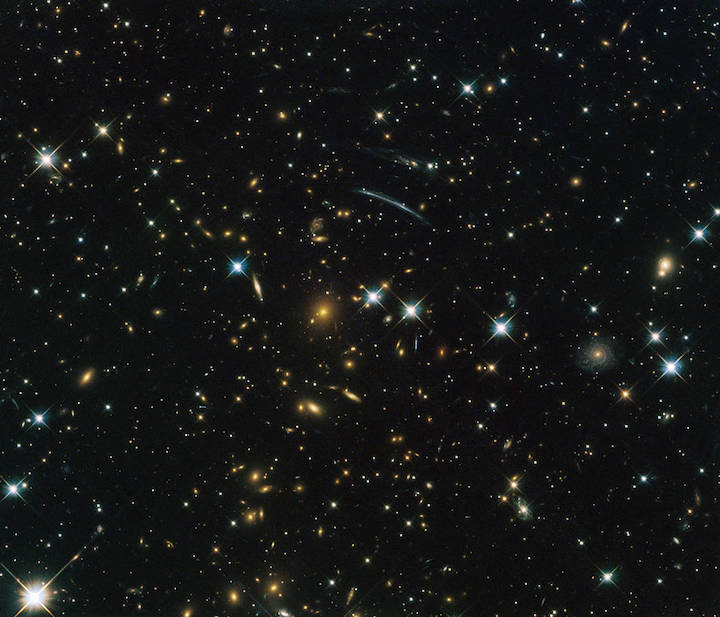The night sky has always been a riddle. Long before telescopes, long before mathematics and physics could be applied to the heavens, human beings gazed upward and wondered what kept the stars in their places. Some thought the universe eternal and unchanging. Others imagined it finite, held together by gods or hidden forces. But in the last hundred years, science has revealed something far stranger and more humbling: the universe is not fixed at all. It expands. Galaxies drift apart, not because of motion through space, but because space itself stretches between them.
At first, this idea was astonishing enough. Yet the deeper scientists probed, the stranger it became. By the end of the twentieth century, astronomers uncovered a revelation so unexpected that it shook the foundations of cosmology: the expansion of the universe is not slowing down, as once thought—it is speeding up. Something invisible, mysterious, and pervasive is pushing galaxies apart at an ever-increasing rate. We call it dark energy, but naming it does not mean we understand it.
This question—why the universe expands faster than expected—is not just an abstract puzzle for scientists. It is a story about the deepest nature of reality, about the hidden forces that shape existence, and about the limits of human understanding. To follow this story is to follow the path of discovery itself, where surprise is the only certainty.
The Discovery of an Expanding Universe
To grasp why acceleration is so startling, we must first return to the beginning of modern cosmology. At the dawn of the twentieth century, the universe was widely believed to be static and eternal. Even Albert Einstein, when he applied his newly created General Theory of Relativity in 1915, assumed the cosmos must be unchanging. His equations suggested otherwise—the universe should be expanding or contracting—but the very idea seemed absurd. To preserve the vision of a static universe, Einstein inserted an extra term, the “cosmological constant,” a kind of mathematical balancing act to keep the cosmos frozen in place.
But nature had other plans. In the 1920s, the American astronomer Edwin Hubble, observing distant galaxies from Mount Wilson Observatory, made a stunning discovery. He found that the light from galaxies was stretched, shifted toward the red end of the spectrum—a sign they were moving away. The farther away a galaxy was, the faster it receded. The universe, then, was not static but expanding.
This revelation overturned centuries of assumption. The cosmos had a history, a beginning, and possibly an end. Einstein, hearing the news, supposedly called his earlier decision to add the cosmological constant his “greatest blunder.” Whether or not he actually used those exact words, the point remained: reality was stranger than even Einstein had dared to imagine.
Expectation: A Slowing Cosmos
Once the idea of expansion took root, scientists considered its natural consequences. If space was stretching, then at some earlier time everything must have been closer together—giving birth to the concept of the Big Bang, a fiery origin of the universe. But expansion should not be unchecked. Gravity, the attractive force of all matter, ought to slow it down. Just as a ball tossed upward slows as gravity pulls it back, so too should the universe’s expansion gradually decelerate.
Astronomers debated whether gravity was strong enough to eventually halt expansion, causing the universe to collapse back in a “Big Crunch,” or whether expansion would continue forever but always slowing, asymptotically approaching a halt. Either way, the expectation was clear: over billions of years, the growth of the universe should weaken, not strengthen.
To measure this cosmic slowdown, astronomers needed a kind of standard candle—a way of gauging distances across unimaginable gulfs. That tool came in the form of Type Ia supernovae, exploding stars of consistent brightness. By comparing their observed brightness to their known luminosity, astronomers could calculate distances with remarkable precision. It was a cosmic yardstick, a way of charting the expansion of space.
The Shocking Discovery of Acceleration
In the 1990s, two rival teams of astronomers set out to measure the deceleration of the universe using these supernovae. Their goal was straightforward: quantify how much gravity had slowed the expansion since the Big Bang. What they found instead stunned them.
The supernovae appeared dimmer than expected—not because they were intrinsically fainter, but because they were farther away than predicted. The only explanation was that the expansion of the universe had sped up. Instead of gravity winning the cosmic tug-of-war, some unknown force was pushing galaxies apart more strongly than anyone had imagined.
In 1998, the teams announced their results. The universe was not just expanding—it was accelerating. A discovery so astonishing that it earned the 2011 Nobel Prize in Physics. This was no minor adjustment to theory; it was a complete upheaval of our understanding of cosmic destiny. Instead of a universe slowly winding down, it was racing outward faster and faster, driven by something entirely mysterious.
Dark Energy: A Name Without a Face
What could be responsible for this acceleration? Scientists coined the term dark energy, a label as enigmatic as the phenomenon itself. It was called “dark” not because it was literally black, but because it lay beyond direct detection. It was invisible, untouchable, and known only through its effects on cosmic expansion.
Dark energy, in current models, makes up about 68% of the total energy content of the universe, dwarfing both the dark matter (27%) and ordinary matter—the stars, planets, and atoms we know—just 5%. In other words, everything familiar, from galaxies to human beings, is only a tiny fraction of reality. The bulk of existence is an unseen force driving expansion.
But what exactly is it? The truth is, no one knows. Several possibilities compete, each profound in its implications.
One idea is that dark energy is simply the cosmological constant Einstein once introduced and later discarded. In this view, it is a property of space itself: as space expands, new “empty” space is created, and that space carries with it an energy that drives further expansion. This model is simple, elegant, and fits observations remarkably well. But it raises a profound puzzle: quantum physics predicts a vacuum energy far, far greater than what is observed—by as much as 120 orders of magnitude. Why is the actual value so tiny? This mismatch is one of the greatest unsolved problems in physics.
Another possibility is that dark energy is not constant but dynamic, evolving with time. Such models are sometimes called “quintessence,” invoking the ancient term for a fifth element beyond earth, air, fire, and water. In this view, dark energy might be a field pervading the cosmos, waxing and waning across eons. If true, it could one day fade, reverse, or unleash cosmic transformations we can scarcely imagine.
A third possibility is that dark energy is not a substance at all but a sign that our theory of gravity itself is incomplete. Perhaps Einstein’s equations, magnificent though they are, need modification on the largest scales. Could gravity behave differently across billions of light-years than it does in our solar system? If so, acceleration might be a clue pointing to a new theory of the universe, one that transcends general relativity.
The Emotional Weight of a Mystery
For scientists, the discovery of dark energy was exhilarating but also deeply unsettling. The more we measure, the clearer it becomes that we inhabit a universe ruled not by the familiar but by the unknown. Imagine building a grand cathedral of knowledge, only to realize its foundation rests on a substance you cannot see or touch, comprising most of reality.
And yet there is beauty in this ignorance. The universe is not simple; it resists our attempts to reduce it to neat equations. This mystery drives human curiosity forward. Einstein once said, “The most incomprehensible thing about the universe is that it is comprehensible.” Dark energy seems to challenge even that sentiment—it may be comprehensible, but only if we dare to look deeper than ever before.
The Hubble Tension: A New Cosmic Puzzle
As if dark energy were not puzzling enough, recent observations have revealed another cosmic riddle. Measurements of the expansion rate of the universe—known as the Hubble constant—differ depending on how they are taken. Observations of the early universe, using the cosmic microwave background radiation left from the Big Bang, predict one value. Measurements of the nearby universe, using supernovae and galaxies, yield a higher value.
This discrepancy, called the Hubble tension, has sparked intense debate. Is it a sign of systematic error in our instruments? Or is it evidence that our cosmological models are incomplete? Some scientists believe this tension might hint at new physics, perhaps tied to dark energy’s nature. Others caution that we may simply need more precise data. Either way, the universe continues to surprise us, refusing to fit neatly into expectation.






